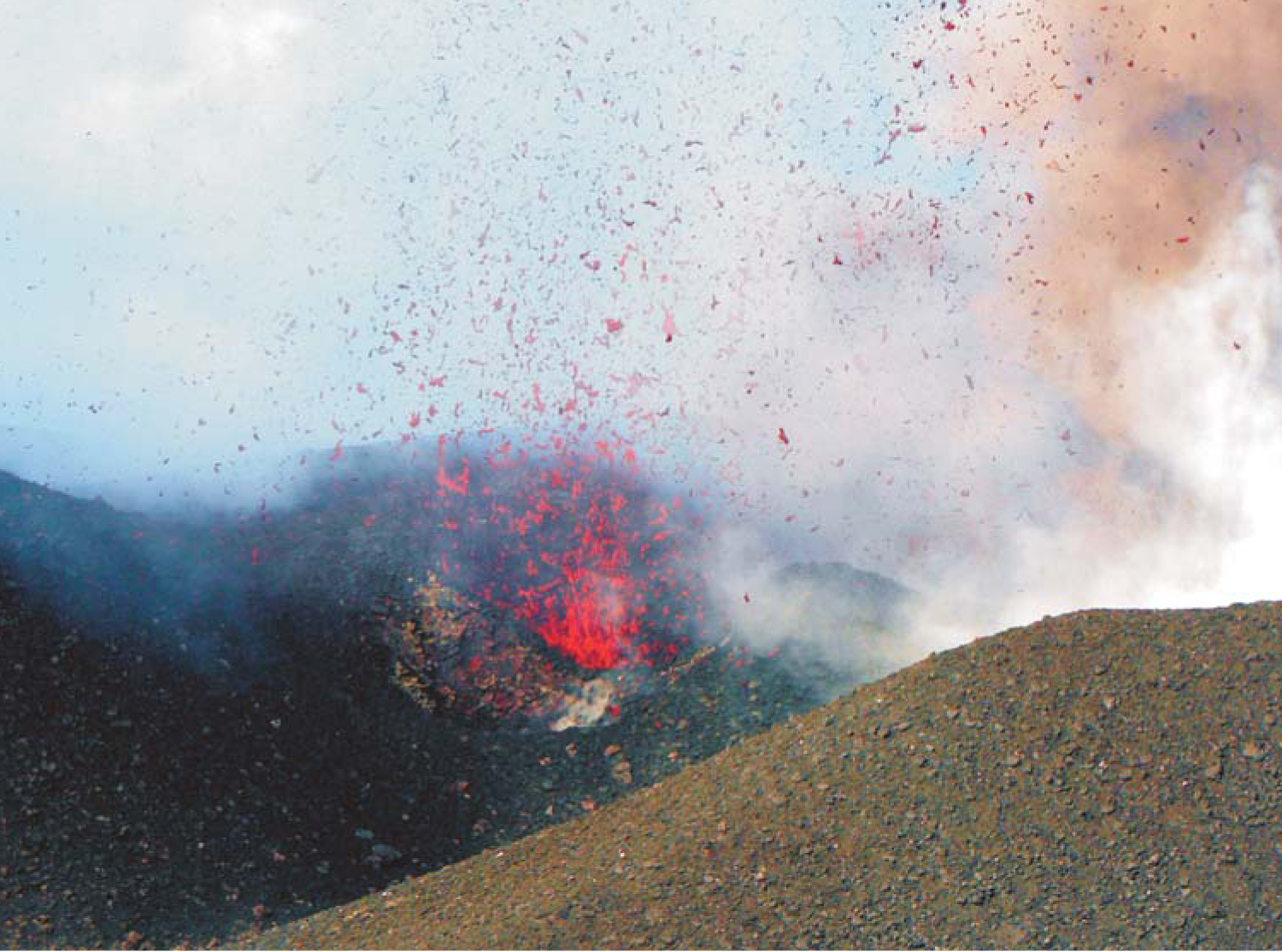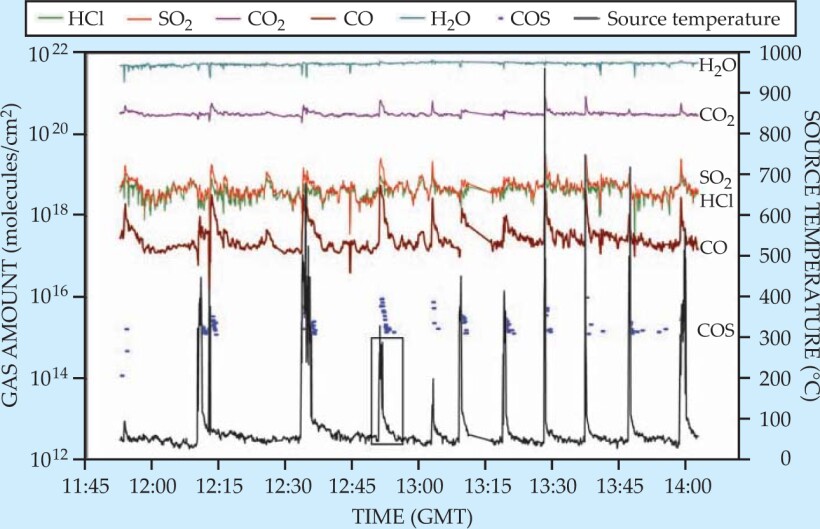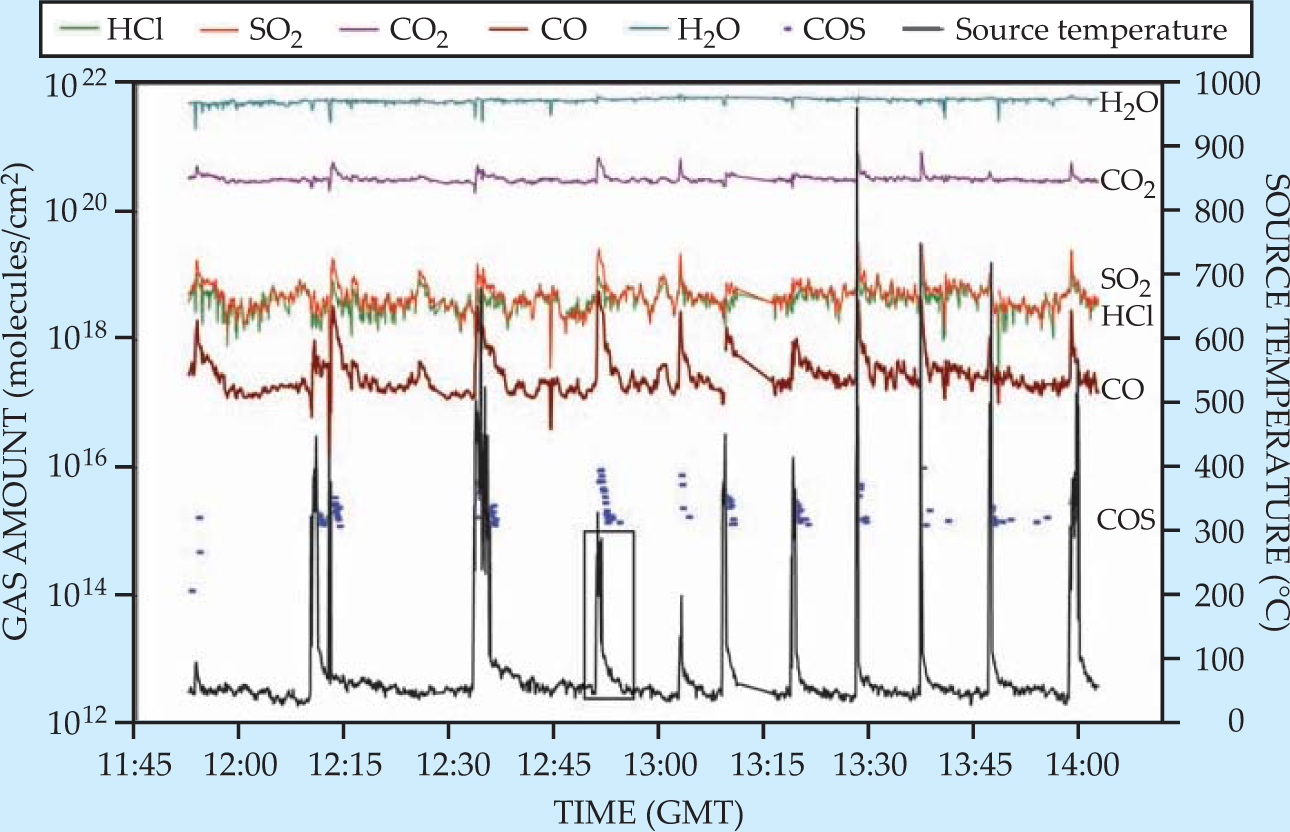Stromboli volcano’s explosions have deep origins
DOI: 10.1063/1.2784671
Stromboli is an unusual volcano. Located on an island of the same name, just north of Sicily, it has been erupting continuously for at least 2000 years. Tourists flock to Stromboli to climb the mountain and witness the explosions that send clots of lava flying out of the volcano’s vent every 10 to 15 minutes. Figure 1 shows the attraction. (Mount Yasur, halfway around the world in the island nation of Vanuatu, erupts in the same way and draws a similar crowd.) The clots usually land within the volcano’s crater and pose no threat to anyone. But once or twice a year, larger explosions endanger the visitors, their guides, volcanologists, and sometimes the few hundred inhabitants of the island’s two small villages.

Figure 1. An eruption of Stromboli volcano, typical of those that have occurred several times an hour for at least two millennia. The eruptions are driven by slugs of gas that rise to the surface and burst.

Forecasting the larger, more dangerous eruptions more than a few minutes in advance is not currently possible. Little is known about the arrangement of the conduits, or plumbing, of Stromboli or any other volcano, so models of volcanic activity are poorly constrained. Now, Mike Burton and his colleagues at the National Institute of Geophysics and Volcanology in Catania, Sicily, have made a substantial addition to that sparse body of knowledge by determining the depth from which Stromboli’s explosions originate. 1
Volcanic eruptions are classified into types named after famous proto-types. Hawaiian eruptions, for example, are relatively gentle flows of low-viscosity lava. Plinian eruptions, named after the AD 79 eruption of Mount Vesuvius described in a letter by Pliny the Younger and more recently exemplified by the 1980 eruption of Mount Saint Helens, are huge explosions that drive large quantities of smoke and ash high into the sky. Strombolian eruptions, seen also in Yasur and other volcanoes throughout the world, are the result of gases dissolved in the magma coalescing into large bubbles called slugs that ascend and burst at the surface, propelling lava into the air. The slugs take up most of the width of the conduits through which they travel, more like the bubbles in a drinking straw than those in a pot of boiling water.
Tiny bubbles
Two mechanisms have been proposed for slug formation. In one, small bubbles coalesce into slugs as bubbles of different sizes rise through the magma at different rates. In the other, many small bubbles accumulate at a structural discontinuity deep within the volcano, where they form slugs that then shoot to the surface.
Burton and colleagues sought to distinguish between the two mechanisms by measuring the composition of the slugs. Different gases have different solubilities in magma, all of them pressure dependent. As magma rises to the surface, the pressure on it decreases, and the gases dissolved in it come out of solution—but not all at the same time. Carbon dioxide comes out of solution first, followed by water vapor, sulfur dioxide, and hydrogen chloride. The ratio of the amounts of any two of those gases gives a measure of the pressure at which a slug formed. Slugs also contain carbon monoxide and carbonyl sulfide, but the amounts of those gases aren’t determined solely by the pressure at which the slug originated. Rather, they form in chemical reactions among the other gases, in amounts that depend on the temperature.
Spectacular as Stromboli’s eruptions are, the slugs that cause them constitute only about 1% of the volcano’s total gas output. The rest comes from quiescent degassing of the magma at the surface. Gas bubbles in the magma that don’t coalesce to form slugs make the magma less dense and cause it to rise to the surface, where the gases are released. The dense, degassed magma then sinks back down through the conduit, pushing a new batch of gas-rich magma to the surface. The composition of the quiescent emissions is different from that of the slugs, but no one knew just how different before Burton and colleagues made their measurements.
Measuring the composition of the slugs is not easy. Because collecting a gas sample in the midst of a volcanic eruption is hazardous, a remote sensor is necessary. The gas from a slug dissipates quickly, mixing with the surrounding air and quiescent emissions, so that getting an accurate measurement requires adequate time resolution. And determining the gas ratios requires measuring many different molecular species simultaneously.
Burton and colleagues met all those requirements with a technique called open-path Fourier-transform IR spectroscopy, which quantifies the composition of the slugs based on the characteristic molecular vibrations of the component gases. With a spectrometer 240 m away from the volcano’s vent, they sampled the IR radiation emitted from the hot surfaces inside the crater. That radiation was passed through a Michelson interferometer and Fourier transformed to give the frequency spectrum. The resulting absorption lines correspond to the vibrational transitions of the gas molecules between the magma and the detector. The composition of the slug gas could then be inferred from the relative strengths of the absorptions. Measurements of H2O and CO2 had to be corrected to account for the presence of those gases in the intervening air, so those measurements had higher uncertainties (20-25% and 10%, respectively) than the measurements of other gases (4-6%).
A representative set of measurements, with a spectrum taken every 4 s, is shown in figure 2. The baseline gas composition is that of the quiescent emissions, and the periodic spikes correspond to the slugs. The data show that the slugs have less H2O, more CO2, and a greater CO2/SO2 ratio than the quiescent emissions, all of which suggest a greater source pressure. “The enormous variation in the CO2/SO2 ratio, to 22 or 23 for the most intense explosions from a background level of 8, was a very pleasant surprise,” says Burton. “No one really had any idea what type of variation there would be, if any.” Smaller explosions gave off gases richer in H2O than the larger slugs, and with a slightly smaller CO2/SO2 ratio.

Figure 2. Fourier-transform IR spectroscopy measurements of the gases emitted by Stromboli volcano. A spectrometer situated 240 m from the volcano vent captured the IR radiation emitted by the ejected lava during an eruption or by the crater floor between eruptions. The volcanic gas amounts (colored lines and points) were derived from the IR absorption spectra of the gas between the source and the detector; amounts are given in molecules per unit area perpendicular to the line of sight. Eruptions coincided with changes in both the source temperature (black line) and the gas composition. When the measurements were corrected to account for the water and carbon dioxide in the air, quiescent gas emissions between eruptions were found to contain 83% H2O and 14% CO2, and had a CO2/SO2 ratio of 7.8. The gas released in one typical explosion, marked by the black box, was 64% H2O and 33% CO2, and had a CO2/SO2 ratio of 18.4.
(Adapted from ref. 1.)

To convert the gas compositions into a pressure or depth of origin, the researchers needed to know how much gas was dissolved in the magma to begin with, so they looked at the analyses of the products of Stromboli’s most severe eruptions. 2 Some 10 km beneath the surface, pockets of basaltic magma become trapped in chunks of olivine (a mineral that solidifies at a much higher temperature than basalt), which are then propelled from the volcano in violent explosions. Starting from the volatile content of the basalt, Burton and colleagues ran a computer simulation of how the magma would degas as it rose through the volcano’s plumbing. They found that the typical slug’s composition corresponded to a depth of origin of about 3 km—right around the level of the sea floor.
That the slugs originate so far below the surface is a clue that they probably form from a foam that builds up at a structural discontinuity rather than from small bubbles that rise steadily through the conduits at different speeds. Although the smaller slugs had a different composition, indicative of a shallower origin of about 0.8 km, the researchers speculate that they might actually form at the same depth as the larger slugs. But because the smaller slugs rise through the magma more slowly, they could become contaminated by the bubbles in the shallow magma they pass through.
Burton and colleagues are currently working on setting up a permanent automatic system to monitor the Strombolian gases. Previously, they had to transport their spectrometer to the peak every time they wanted to take a measurement. That meant obtaining only snapshots of activity and taking no measurements during the larger explosions. The researchers also hope that their measurements will eventually lead to the discovery of a warning signal for the largest, most dangerous eruptions. “The slugs don’t just bring gas from that depth,” says Burton. “They also bring information, and that’s extremely precious.”
References
1. M. Burton, P. Allard, F. Muré, A. La Spina, Science 317, 227 (2007). https://doi.org/10.1126/science.1141900
2. A. Bertagnini, N. Métrich, P. Landi, M. Rosi, J. Geophys. Res. [Solid Earth] 108, 2336 (2003). https://doi.org/10.1029/2002JB002146
